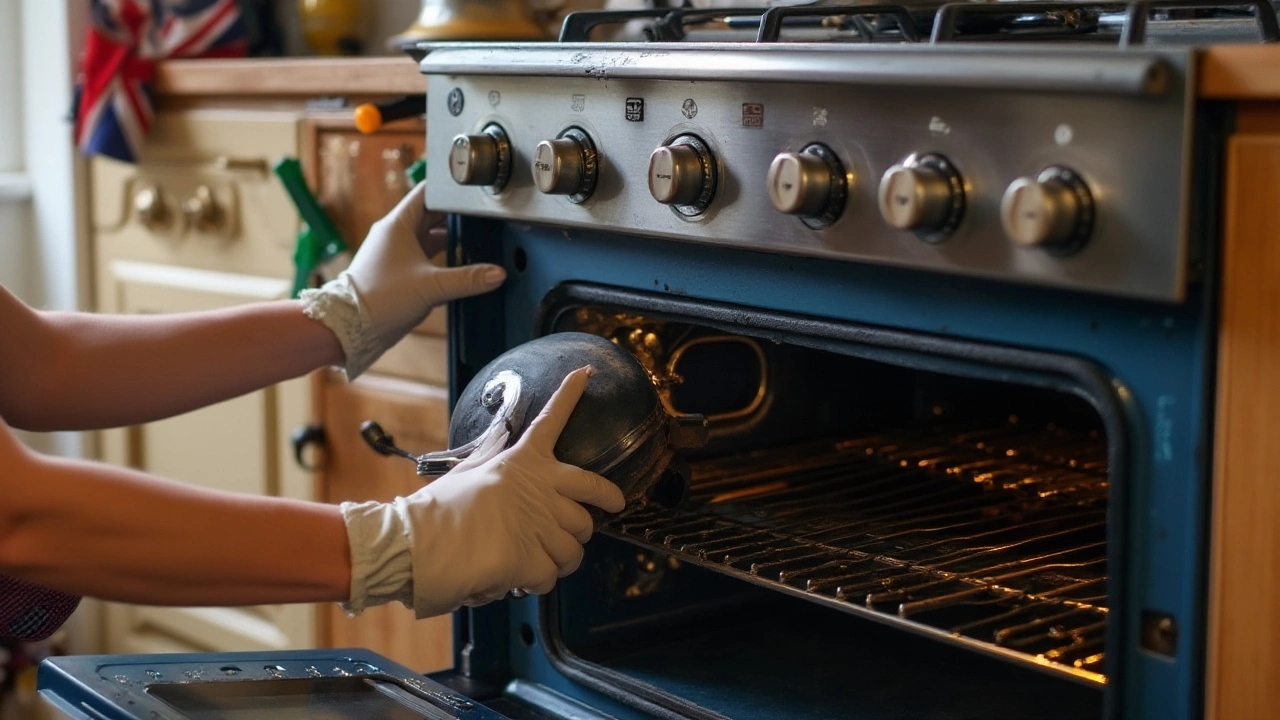Ever found yourself in the middle of baking your favorite dish, only to realize your oven isn't heating up properly? It's a frustrating scenario, especially when your famous lasagna is on the line. But wait, before you call in the professionals or rush to buy a new one, consider this – you might just be able to fix it yourself.
Many home cooks don't realize that replacing a faulty oven element is often a straightforward process. With a bit of know-how and the right approach, it can be done over a leisurely weekend afternoon. Engaging with such home repairs not only gives you a sense of achievement but also saves you a hefty repair bill.
Let's delve into how you can identify the issues with your oven element, what tools you'll need on hand, and walk through the steps to bring your appliance back to life. With practical safety tips, you'll soon have your kitchen humming and ready to tackle those delicious recipes once more.
- Understanding Your Oven's Heating Element
- Signs You Need to Replace the Element
- Tools and Materials You'll Need
- Step-by-Step Replacement Process
- Safety Tips and Troubleshooting
Understanding Your Oven's Heating Element
The oven's heating element plays a vital role in your appliance's performance. This component is responsible for generating the heat necessary to cook food evenly. It's essentially a coil made from high-resistance wire, often coated in a protective sheath. These elements are usually nestled at the top and bottom of the oven compartment, working together to maintain the desired temperature. Understanding its function provides insight into why it might fail and when it requires replacing.
"A heating element is a quiet workhorse of your oven; without it, you're just staring into a cold metal box." - Appliance Repair Expert, Jane Kavanagh
There are generally two main types of heating elements found in modern ovens: the bake and broil elements. The bake element is located at the bottom of the oven cavity, providing the primary source of indirect heat. It warms the air inside, crucial for processes like baking and roasting. The broil element, on the other hand, is positioned at the top, offering direct heat primarily used for broiling and browning dishes. If you're ever unsure about which element does what, a simple look into your oven usually clarifies.
Some modern ovens also feature a convection system, which employs a fan to circulate hot air, improving cooking efficiency. Though not a traditional element per se, it interacts with the heating elements to create an even cooking environment. Now, what might cause these elements to stop working? Wear and tear due to repeated heating cycles can lead to cracking or breaks in the element. In some cases, food residues or cleaning chemicals might also contribute to decreased functionality.
Spotting the Issue
A common sign that your oven heating element needs attention is if you notice uneven cooking results or a longer than usual preheat time. Visual inspection can also reveal issues: a burnt-out element may have visible damage such as blistering or a dull, discolored appearance. Understanding the symptoms your oven exhibits when elements fail is crucial. This knowledge allows you to perform timely maintenance, potentially avoiding a complete breakdown during a crucial cooking occasion.
Let's also discuss some interesting statistics. A recent survey by the Home Appliance Manufacturers Association found that more than 60% of oven issues are related to heating elements, highlighting just how common this problem can be for households. Regular maintenance and prompt attention to anomalies can extend the life of your appliance significantly. As we venture into the replacement process, this foundational understanding is indispensable.
Signs You Need to Replace the Element
Imagine getting ready to bake a well-prepared pizza only to find that your oven simply won't cooperate. Understanding when your oven's heating element needs replacing can save you from culinary disappointments. Faulty elements can cause undercooked food, delayed cooking times, or, in worst cases, no heating at all. One pivotal indicator is an uneven heat distribution causing hot spots in dishes. If you notice that some sections of your bake are burnt while others remain raw, the element could be the culprit. The inconsistency in heat is often an early red flag.
Another noticeable sign is if the element appears damaged or detached. These elements are typically visible at the back or bottom of the oven, and any visible crack or split may hint at the need for replacement. Additionally, an element that appears to be glowing only partially or not at all when on high settings requires attention. A burnt-out element might not visually show disruptions, but a multimeter can measure continuity, which electricians swear by as the undisputed guide. When it registers infinite resistance, it's time for a change.
"Your oven's performance is the silent hero behind a great home-cooked meal," affirms Helen Daniels, a seasoned home appliance expert, "Monitoring its health is essential for the vibrant energy of your kitchen."
Electrical safety warnings shouldn’t be ignored either. Tripping circuit breakers or unusual sounds like buzzing during operation can be ominous signs of electrical failures, potentially tied back to malfunctioning components. Practicing regular maintenance and being responsive to these signs ensures that you sustain both safety and efficiency in your culinary endeavors. For those precise cooks out there, an oven thermometer can be an excellent tool to verify the internal temperature accuracy, thus revealing potential deviations.
While DIY feels rewarding, a prudent approach is essential. Before assuming the issue lies solely with the element, inspect and rule out other components like the thermostat or wiring. Often overlooked, these parts might cause similar symptoms but different solutions. By effectively identifying the need for a new element, you extend the life of your oven repair adventures, ensuring that you are equipped for the best outcomes in your cherished kitchen space.

Tools and Materials You'll Need
When embarking on a DIY mission to replace your oven's heating element, it's crucial to gather all necessary tools and materials beforehand. Proper preparation saves you time and prevents the frustration of multiple trips to the hardware store. The core of this task relies on having the right equipment at your disposal, ensuring not only efficiency but also safety during the repair process. Let's dive into the essentials you'll need. First, a Phillips head screwdriver is indispensable since you'll need it to unscrew the element and access the oven's wiring compartment. A flathead screwdriver may also come in handy, especially if your oven model features additional flathead screws or panels. Needle-nose pliers are essential for precision work when removing and reattaching wires. These tools help you safely grip and maneuver potentially tricky connectors.
It’s also a good idea to have a digital multimeter. Often overlooked by DIY enthusiasts, a digital multimeter is priceless when checking continuity and ensuring the element is truly the issue. This handy device helps you avoid unnecessary replacements, saving both time and money. Speaking of safety: electrical tape is non-negotiable for covering exposed wires and ensuring that all connections are resecured properly once the new element is in place. Additionally, work gloves, made from strong materials, are highly recommended to protect your hands from sharp edges and residual heat within the oven cavity. To shield yourself further, grab a flashlight or a headlamp; a well-lit workspace is critical to avoid errors or accidents during your repair endeavor.
Most importantly, you’ll need the correct replacement heating element for your specific oven model. Identifying the exact model number is crucial here, typically found on a label just inside the oven door. Cross-check this with your replacement part's compatibility to avoid purchasing the wrong element. As unfortunate as it may be, rushing to purchase a part only to realize it doesn't fit can occur, turning a simple repair into a frustrating ordeal.
As noted by the appliance experts at Consumer Reports, "Knowing your appliance's model number not only ensures you get the correct part but also provides valuable insights into compatible tools and safety specifications."Feel free to browse local hardware stores or reputable online retailers for your part. Oftentimes, your oven's manufacturer website provides the most precise list of compatible components.
For those who love a checklist, here's a quick rundown: Phillips and flathead screwdrivers, needle-nose pliers, digital multimeter, electrical tape, work gloves, flashlight/headlamp, and your new heating element. As you gather these items, remember that each one plays a unique role in achieving a successful and safe repair. So there you have it—a well-prepared array of tools and materials sets the stage for a smooth replacement process, leaving your kitchen ready to take on any culinary challenge with your now fully functioning oven.
Step-by-Step Replacement Process
Embarking on a DIY oven repair adventure starts with ensuring you have the right equipment and a safe plan to follow. The first thing you want to do is make sure your oven is completely disconnected from any power source—this cannot be stressed enough for safety reasons. We’re dealing with electricity here, and safety is always the top priority. Locate your circuit breaker and turn off the power to the oven. Once you’ve ensured there’s no power, double-check for peace of mind. This procedure might sound like common sense, but skipping this crucial step can lead to hazardous situations.
Next, it's time to investigate the heating element itself. Open the oven door and remove any racks inside to give you clear access to the unit. You'll typically find the element at the bottom of the oven cavity—its distinctive, horseshoe shape is pretty hard to miss. Depending on your oven model, there might be screws holding it in place. Use a screwdriver to carefully take these out. Keep a small container nearby to ensure these screws don't go missing—they're tiny but mighty important.
Once the screws are removed, your next move is to gently pull the element towards you. It should come out a few inches, exposing the wires connected at the back. Now, carefully detach these wires. A quick tip here is to take a photo of the current setup before detaching anything, so you have a visual guide during reassembly. Be gentle with the wires; they can be brittle due to heat exposure over time. Disconnect them carefully to avoid damage, which could complicate the repair.
This brings us to installing the new oven element. Start by attaching the wires to the new element, ensuring you follow the reference photo you took earlier. Each wire should align with its matching terminal to ensure proper function. Once the wires are securely in place, slide the coil back into the oven cavity gently. Using your screwdriver, replace the screws you stored safely earlier. Make sure everything is snug and secure, as a loose connection might lead to problems down the line.
Before concluding the process, it's always wise to give a once-over to make sure nothing seems out of place. Once satisfied, replace any oven racks and restore power at the breaker panel. This is the moment of truth. Turn on your oven to test the new element. If the oven repair went well, you'll notice the oven warming up efficiently. In case of any malfunctions, revisit each step to ensure everything followed the outlined path.
"Replacement of heating elements requires meticulous attention to safety and detail, but it's an empowering DIY task that can save both time and money," noted the professionals from Popular Mechanics.

Safety Tips and Troubleshooting
Before diving hands-on into replacing your *oven heating element*, let’s place safety front and center. The first and most critical piece of advice is to disconnect your oven from the electrical outlet before undertaking any repair. It may seem obvious, but it's crucial for preventing electric shock. While some ovens will simply unplug from a wall outlet, others might be hardwired. In these cases, you might need to switch off the corresponding circuit breaker. Be sure to check twice before proceeding—better safe than sorry.
It's also wise to wear protective gear. Gloves will shield your hands from sharp metal parts and potential burns. Safety glasses are recommended when handling glass or brittle wires. While replacing your heating element, ensure you have a solid working space to avoid any balance mishaps. An uneven surface can lead to slips or even a dropped appliance, which could not only harm you but also damage your oven beyond the simple repair you set out to accomplish.
Once you’re dealing with any exposed electrical wires, keep in mind that color coding matters. Typically, heating elements will have two wires connected with screws or metal clips. When removing the old element, take note of which wire is connected to which terminal. Mixing these up can result in circuit issues later. It helps to take a quick photo before disassembly—our smartphones are quite handy tools in the modern DIY repair kit.
"Safety isn’t expensive, it’s priceless," as Jerry Smith suggests, capturing the essence of precaution as we tackle home repairs.
If, after replacing the heating element, you find the new component isn’t functioning as expected, it’s time to troubleshoot. First, double-check those connections. Ensure wires are tightly fitted and screws are properly fastened. If a thermal fuse or thermostat is faulty, the oven might not work even with a new element. These components can often be sourced easily online or at local appliance parts shops if they need replacing.
At times, issues might not directly point to the *heating element*. Should troubleshooting become complicated, consider using a multimeter to assess electrical continuity. This device can help identify whether electricity is properly passing through the element, an essential check when other solutions don’t remedy the problem. However, when repairs delve into the complexity of circuit boards or advanced diagnostics, a professional's insight could save both time and resources.
Lastly, keep records of part numbers and take notes as you undertake each step. Not only does this assist with your understanding, but it also creates a helpful log if future repairs arise. Who knows, it may even inspire you to tackle more advanced *DIY home repair* tasks down the line, comforting in the knowledge you’ve conquered this one with the right balance of caution and confidence.
